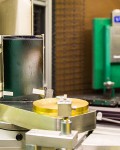Many filtration, or “separation,” processes impact our everyday lives: in our kidneys, biological filtering separates waste products from our blood; in coffeemakers, paper filters keep the grounds out of our coffee; and in pharmaceutical manufacturing, synthetic membranes help keep bacteria out of our medicines. The use of synthetic membranes in industrial processes is estimated to grow to a nearly $62 billion global market by 2025—thanks in part to new separation technologies.
Membranes are semi-permeable materials used in many separation processes because of their energy efficiency, continuous operation capabilities, and relatively low capital investment and environmental impact. One type, mixed matrix membranes (MMMs), has drawn the interest of researchers from the California Institute of Technology (Caltech), who are using neutron scattering techniques at the Department of Energy’s (DOE) Oak Ridge National Laboratory (ORNL) to study novel types of these membranes.
Unlike conventional MMMs based on polymers and inorganic particles, Caltech’s mixed matrix polymer-polymer (M2P2) membranes combine two types of polymers, one that provides strength and another that provides new functionality.
“During fabrication, the functional polymer becomes interlocked with the structural one, so the two can’t separate later on. The subsequent membrane offers long-lasting functionality in applications ranging from water purification to environmentally friendly chemical production,” said Rachel Ford, a graduate student at Caltech.
Ford, along with fellow Caltech graduate student Orland Bateman, spent several days at ORNL’s Spallation Neutron Source (SNS), conducting preliminary measurements at the Extended Q-range Small Angle Neutron Scattering, or EQ-SANS, instrument, and performing their experiments at the Ultra-Small-Angle Neutron Scattering (USANS) instrument.
The challenge in making Caltech’s M2P2 membranes is that different types of polymers don’t normally mix. To overcome this obstacle, the researchers turned to an innovative process using building blocks of the functional polymer that do mix with the strong polymer. The building blocks are stitched together into functional polymers and, before they have time to retreat from the strong polymers, the mixture is quickly solidified to permanently lock the polymers together in the membrane.
Mamadou Diallo, who developed the process as a professor at the Korea Advanced Institute of Science and Technology, said, “The new approach works for a wide variety of functional polymers, which will enable us to address challenges in water purification, metal extraction, resource recovery, bioseparation, catalysis, chemical manufacturing, and other separation applications.” Diallo is now appointed at Caltech in the Division of Engineering and Applied Sciences.
Julia Kornfield, who heads up the Caltech research team, said, “Going forward, as we incorporate different functional polymers, ultra-small angle neutron scattering will help us understand the formation of the membrane features, which range in size from as small as the diameter of a DNA strand to larger than a blood cell.”
Neutrons are uniquely suited to probe membranes, because they are nondestructive and can probe the full depth of most materials. Ultra-small-angle neutron scattering at ORNL offers exceptionally high angular resolution, permitting the scientists to characterize features up to 20 micrometers in size within their membranes.
“The physical properties of the membrane are difficult to examine using traditional optical techniques, necessitating the use of neutrons,” Bateman said. "As a result of our recent USANS experiment, we have drawn connections between certain processing steps and the final membrane structure. This will enable us to tailor the membrane fabrication process to maximize performance for a chosen application.”
The project was supported by the DOE Office of Science.
SNS is a DOE Office of Science User Facility. ORNL is managed by UT-Battelle LLC for the DOE Office of Science, the single largest supporter of basic research in the physical sciences in the United States. The Office of Science is working to address some of the most pressing challenges of our time. For more information, visit https://energy.gov/science.— by Paul Boisvert







